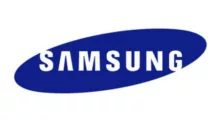
Samsung Galaxy J1 Ace: Pros and Cons
Samsung announced the launch of the Galaxy J1 Ace smartphone in 2015. The manufacturer is offering this smartphone with 4.3 inch Super AMOLED display, Marvell Armada PXA1908 SoC, and 1 GB of RAM. It comes with Android OS v4.4.4 (KitKat) out of the box, and a Li-Ion 1900 mAh battery. The 4.3 inch AMOLED displays has fast response times. This smartphone has a single camera on the back (5 MP, 2592 x 1944 px, autofocus).
Table of Contents
- Samsung Galaxy J1 Ace specifications
- Weight, dimensions, colors
- System, chipset, performance
- Display type, size, resolution
- Memory, storage
- Cameras, flash
- Connectivity, network, wireless
- Battery type, capacity, charger
- Features, sensors, specials
- Verdict, pros and cons
This article shares our personal experiences and thoughts about using the Samsung Galaxy J1 Ace smartphone. We hope to offer helpful insights to others interested in this device. The specifications below are from the official manufacturer data, but we also consider user reviews. If you've seen any mistakes or things missing in these specifications, please let us know.
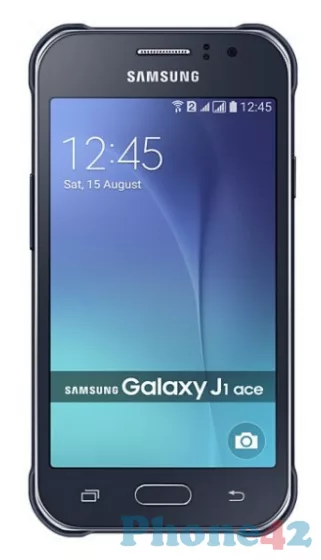
Samsung Galaxy J1 Ace specifications
| Brand | Samsung |
|---|---|
| Name | Galaxy J1 Ace |
| Model | SM-J110M |
| Release date | 2015 |
Weight, dimensions, colors
| Weight | 4.62 oz |
|---|---|
| Dimensions | 5.12 x 2.66 x 0.37 inch |
| Colors | black, white |
| SIM type | Micro SIM |
The weight of Samsung Galaxy J1 Ace is about 4.62 oz with battery. This is average for smartphones of the same size. A micro SIM is a smaller version of the standard SIM card used in mobile devices.
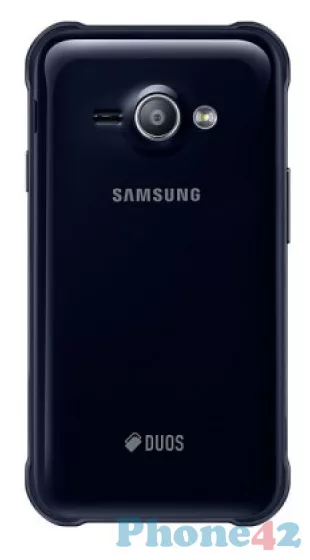
System, chipset, performance
| OS version | Android OS v4.4.4 (KitKat) |
|---|---|
| SoC | Marvell Armada PXA1908 |
| CPU | Quad-core 1.2 GHz Cortex-A53 |
| GPU | Vivante GC7000 |
The Samsung Galaxy J1 Ace comes with Android OS v4.4.4 (KitKat) out of the box. Google has integrated many services with Android. These include Google Maps, Gmail, and Google Drive. The mid-range CPU can deliver fast, efficient performance for many tasks.

Display type, size, resolution
| Display type | Super AMOLED |
|---|---|
| Screen size | 4.3 inch |
| Resolution | 480 x 800 px |
| Multitouch support | yes |
The 4.3 inch phone comes with AMOLED display. Smartphones use the AMOLED, which is a type of OLED display. Smaller smartphones are generally more compact and easier to handle. The size of the screen is measured diagonally, from corner to corner.

Memory, storage
| RAM | 1 GB |
|---|---|
| Internal storage | 8 GB |
| Memory card slot | microSD |
1 GB of RAM is not typically considered to be enough for a smartphone. Having more RAM alone does not guarantee better performance. Most people think a smartphone needs at least 32 GB of storage. The Galaxy J1 Ace has only 8 GB. You can expand the internal storage (8 GB) with a compatible microSD card.
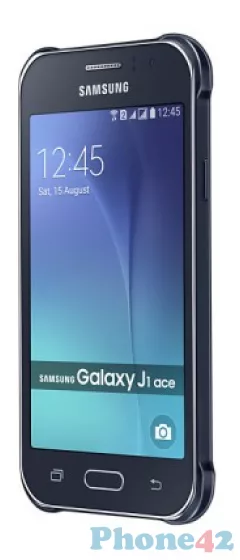
Cameras, flash
| Main camera | 5 MP, 2592 x 1944 px, autofocus |
|---|---|
| Flash | LED |
| Selfie camera | 2 MP |
The single camera can be enough for many smartphone users. It depends on their photography needs and preferences. The Galaxy J1 Ace does not have optical image stabilization (OIS).
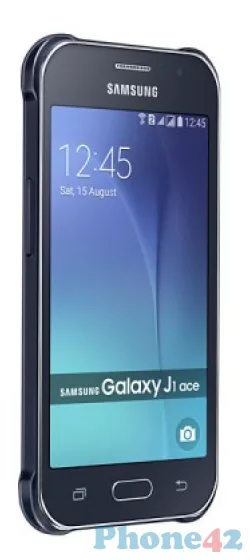
Connectivity, network, wireless
| GSM 2G bands | 850 / 900 / 1800 / 1900 |
|---|---|
| Network coverage | 2G / 3G / 4G |
| Wi-Fi | Wi-Fi 802.11 b/g/n |
| Bluetooth | v4.0, A2DP |
| GPS | A-GPS, GLONASS |
| NFC | no |
| FM radio | yes |
| USB | microUSB 2.0 |
| Headphone | 3.5 mm jack |
The Samsung Galaxy J1 Ace supports 4G/LTE networks. This phone like all modern smartphones, is capable of connecting to Wi-Fi networks. The Galaxy J1 Ace smartphone is capable of connecting to Bluetooth devices. This phone has a built-in GPS. The phone isn't NFC (Near Field Communication) capable. NFC is not essential for basic phone functionality, but it can be useful. The 3.5 mm headphone jack allows you to connect wired headphones or earphones to the device.
Battery type, capacity, charger
| Type | Li-Ion 1900 mAh |
|---|
The Li-Ion 1900 mAh battery gives the smartphone a good battery backup. The Li-ion is a low maintenance battery. It does not need periodic full discharge. You can simply buy a new battery from the open market and interchange it by yourself.
Features, sensors, specials
| Sensors | accelerometer, proximity |
|---|
Today, smartphones come with many sensors. They help make the user experience better. The accelerometer provides information about the smartphone's movement in three axes. These are X (horizontal), Y (vertical), and Z (depth).
Verdict, pros and cons
Every phone has its strengths and weaknesses, and this Samsung phone is no exception. As with any device, there are aspects that shine and others that fall short. By examining both sides, we can paint a complete picture of what this phone has to offer. Let's explore its standout features and areas for improvement. Remember, this is just my opinion, and yours might be different.
Pros
- Super AMOLED display
- microSD slot
Cons
- limited-size screen
- insufficient memory
- insufficient internal storage
- single camera setup
- no OIS function
- no 5G support
- no NFC feature
- no Type-C USB port
- low-capacity battery
- no digital compass
- no fingerprint reader
Please let us know if you find incorrect information or something isn't working. Also, tell us if you have a suggestion for improvement.
 I'm Lucas Bradley, the founder of the Phone42.com site. I love technology, especially smartphones, and I've been working with tech stuff for more than 20 years. This means I've seen a lot of changes and have learned a bunch about what makes a good phone. On Phone42.com, I look at all kinds of phones. They can be from big, well-known companies or new ones trying to make their mark. I want to help people understand what's new and cool in the world of smartphones, in a way that's easy to get.
I'm Lucas Bradley, the founder of the Phone42.com site. I love technology, especially smartphones, and I've been working with tech stuff for more than 20 years. This means I've seen a lot of changes and have learned a bunch about what makes a good phone. On Phone42.com, I look at all kinds of phones. They can be from big, well-known companies or new ones trying to make their mark. I want to help people understand what's new and cool in the world of smartphones, in a way that's easy to get.